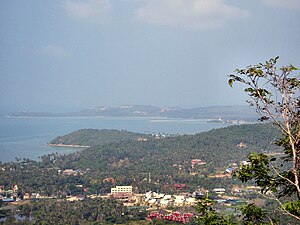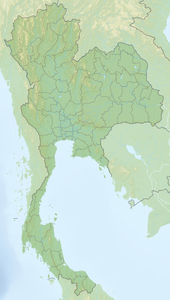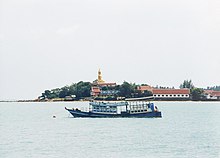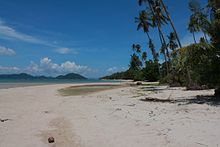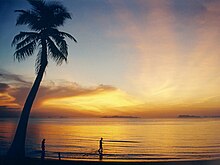Ko Samui
| Ko Samui | ||
|---|---|---|
| View over Ko Samui | ||
| Waters | Gulf of Thailand | |
| Archipelago | Mu Ko Samui | |
| Geographical location | 9 ° 30 ′ N , 100 ° 0 ′ E | |
|
|
||
| length | 26 km | |
| width | 21 km | |
| surface | 233 km² | |
| Highest elevation |
Khao Thai Kwai 635 m |
|
| Residents | 45,873 (2004) 197 inhabitants / km² |
|
| main place | Ban Na Thon | |
| Ban Na Thon Harbor | ||
Ko Samui ( Thai เกาะสมุย [ kòʔ samǔj ]) is an east of Kra Isthmus Located about 35 kilometers from the mainland in the Gulf of Thailand located island ( Thai : Ko or Koh ) in the province of Surat Thani ( Thailand ).
Ko Samui is also the headquarters of the administrative district ( Amphoe ) Ko Samui .
geography
With an area of 233 km² , Ko Samui is the third largest island in Thailand after Ko Phuket and Koh Chang . It is part of the Samui Archipelago ( Muu Ko Samui ), to which around 60 other islands belong, including Ko Pha-ngan , Ko Tao , Ko Nang Yuan , Ko Taen and the around 40 islands of the Ang Thong National Park . Samui is 258 nautical miles south of Bangkok. At the narrowest point it is 21 kilometers and at the widest point 26 kilometers wide.
The interior of the country is a mountain landscape that is largely covered by secondary forest. With the exception of a few remains, the original jungle was cut down a long time ago to make room for plantations. The highest mountain is the 635 m high Khao Thai Kwai in the southwest of the island. A 51-kilometer ring road runs around the island, mostly along the coast.
Ferries connect the capital Ban Na Thon with the provincial capital Surat Thani on the mainland as well as with the northern neighboring islands Pha-ngan (also accessible from Mae Nam and Bo Phut) and Tao.
History and culture
origin of the name
The origin of today's name Samui has not yet been finally clarified. Possibly it derives from the name of a native tree, the Mui . Another explanation is the derivation of the Malay word Saboey , which means "safe haven".
history
According to the legends that are told about it, Samui has been settled at least temporarily for 1500 to 2000 years. At that time, Chinese seafarers are said to have landed on the island to take in fresh drinking water and repair their ships. The island was first drawn in 1687 under the name Pulo Cornam on old maps from the time of the Ming Dynasty in the Chinese Empire . Shipwrecks discovered off the coast of Samui, contained Chinese ceramics from the 17th century.
Samui had also long been known to fishermen from Malaysia in the south . In the 18th century, settlers from the Chinese island of Hainan settled permanently, and Thais from the mainland soon joined them. It got mixed up with the locals very quickly. It was during this time that the 'artificial' structure of the almost closed coconut palm belt along the beaches was created. At the beginning of the 20th century, Muslim fishermen came from the southern provinces of Thailand.
Culture
This mixture of different ethnicities and religions and a largely self-sufficient existence allowed the islanders to develop a special self-confidence. So they see themselves not only as Thai , but above all as Chao Samui , the "people of Samui".
religion
The majority of the population is now followers of Theravada - Buddhism . As in the other southern provinces of Thailand, the proportion of Muslims is relatively high at 20%. But while on the mainland for decades sometimes violent conflicts have broken out between the Buddhist and Muslim Thai, on Samui they live peacefully next to and with one another. The main difference is that the Chao Samui have a common history, while the provinces on the mainland near the border with Malaysia used to be independent principalities or Muslim sultanates .
There are a number of Buddhist temples ( Wat ) on Samui .
The best known is the gilded twelve meter high Buddha statue , the "Big Buddha" ( พระ ใหญ่ - Phra Yai ) of Wat Phra Yai ( วัด พระ ใหญ่ ), which was built in 1972 on the small offshore island Ko Fan ( เกาะ ฟาน ) opposite the northern one beach of Bang Rak was built. Less known is the also gilded Chedi Laem So ( เจดีย์ แหลม สอ ) built on the southernmost cape of the island . In Wat Khunaram ( วัด คุณา ราม ), near the town of Ban Hua Thanon , the mummified body of the monk Luang Phor Daeng Payasilo ( หลวง พ่อ แดง ปิย สี โล ), who died in 1973 at the age of 79 during meditation, can be seen and his body , still in the same sitting position, showing little signs of decay.
The oldest house still inhabited today on Ko Samui was built in 1850.
economy
Fishing and agriculture
Traditionally, fishing and the management of palm plantations were the most important branches of the economy. Even today, the products of the plantations are the largest source of income after tourism. In addition to more than two million coconuts per month - and they are considered the best in Thailand - it is mainly the copra made from coconuts that is exported . In addition, the fibers of the nuts are used to make mats, the wood is used as building material and for everyday objects, and the leaves are still sometimes used to cover houses.
Other agricultural products are mainly durian, which is notorious for its smell, and rambutan fruits (Thai: Ngo , เงาะ pronunciation: [ ŋɔ́ʔ ]).
tourism
In the 1970s Ko Samui was "discovered" by dropouts (see also Hippie ) who had previously become involuntary pioneers of mass tourism in Ibiza , Goa and Bali . However, it was not until the late 1980s that Samui became a destination for “normal” long-distance travelers . Until then, the journey, a night train ride from Bangkok to Phunphin , the main station of Surat Thani , followed by at least a three-hour boat trip to the island's capital Ban Na Thon , had been complicated and very strenuous. Then the journey was increasingly improved, first with air-conditioned buses and own ferries, and finally in 1989, with the opening of Ko Samui Airport in the northeast of the island, package tourism was also made possible.
The 70-minute flight from Bangkok made Samui an easily accessible “dream island” for international tour operators and their customers. Meanwhile (2005) the airport is also served by direct flights from Singapore , Phuket , Pattaya , Chiang Mai , Krabi and Hong Kong . Today around 1.2 million tourists from all over the world visit the island every year .
As a result of the tsunami of December 26, 2004 , which destroyed parts of the tourist infrastructure in the Thai tourist centers of Phuket and Khao Lak , the number of package travelers on the island of Ko Samui, which has remained untouched by the effects of the earthquake due to its location in the Gulf of Thailand, has almost increased doubled.
The coastal sections most popular with tourists because of the wide beaches and fine sand are the beaches of Chaweng , the tourist center of Samui, and Lamai in the east and the slightly less developed bays of Mae Nam and Bo Phut in the north.
On Samui it is only allowed to build a maximum of “palm trees”, i.e. usually two storeys, whereby large hotel buildings should be avoided and the original flair should be preserved.
In the vicinity of Ko Samui, Ko Pha-ngan , Ko Tao and the islands of the Ang Thong National Park are destinations for day trips.
The downside of tourism on Samui, advertised as a "dream island", is particularly noticeable for the original inhabitants.
Many complain that they have lost their land to mainland and foreign entrepreneurs.
The coconut palm groves that once lined the numerous beaches along the entire coast have now disappeared in many places.
The way to the beaches, which are public spaces everywhere in Thailand, is hindered or blocked in the most touristically developed areas by hotels and bungalow resorts.
The prices for food have generally risen so much that the locals are now paying the same prices as the tourists.
The prices for meat and rice have risen by 300% within a few years.
While it used to be common to buy fish in pieces at the markets, nowadays only whole fish are offered, as this is preferred by the tourist restaurants.
Due to the population growth on the island, the quality and quantity of the drinking water, which traditionally could be drawn from wells, have suffered.
Today the islanders often have to use bottled water.
The easy accessibility - the airline Bangkok Airways now operates 10–20 flights a day to the island, two shipping companies go to the island more than 30 times a day with car ferries - has caused the traffic on the 53 km long ring road to grow significantly, which also increases the risk of accidents increased.
Although there are now four private hospitals on the island, not all of them can afford the high prices.
The 40,000 locals and over 100,000 seasonal unskilled workers often have to be content with the state hospital with 166 beds, in which only 11 doctors work.
On the other hand, many new (private) clinics were built in recent years up to 2014.
The numerous pharmacies distributed over the island also guarantee quick and inexpensive supply of medicines for simple illnesses with advice from pharmacists.
It is not uncommon for pharmacies to employ nurses who offer similar activities to outpatient care services in Germany.
The blue coconut leaf beetle ( Tetrastichus brontispae ) has been spreading on Samui since summer 2005, causing the coconut palms to die off.
80% of the palm trees are said to be infested.
Since the end of October 2005 attempts have been made to get the plague under control with biological means.
Wasps ( called tanbian ) are used for this, which were specially imported from Vietnam . With the help of wasps, which have already proven themselves in other countries as a remedy against coconut leaf beetles, the insect infestation of the palm trees is to be brought under control within a period of two years.
Tourism with all its consequences, such as building activity and the partial destruction of the original fauna and flora, is also considered to be one of the causes of the disturbances in the island's ecological system.
climate
Located in the middle of the tropics , the island's climate is humid and changeable. Temperatures of over 30 ° C are measured all year round, and the water rarely gets colder than 28 ° C. The sea is calm from February to April. Rain during this time means short, heavy showers in the afternoon. From November to mid-December is the rainy season with often heavy monsoon rains. From May to the end of September, storms sometimes hit the island at night.
|
Average monthly temperatures and rainfall for Ko Samui
Source: wetterkontor.de
|
||||||||||||||||||||||||||||||||||||||||||||||||||||||||||||||||||||||||||||||||||||||||||||||||||||||||||||||||||||||||||||||||||||||||||||||||||||||||||||||||||||||||||||||||||||||||||||||||||||||||||||||||||||||||||||||||||||||||||||||||||||||||||||||||||||||||||||||
environmental Protection
The coral reefs off Ko Samui are threatened by deforestation and the associated excessive soil erosion , as well as a lack of sewage treatment plants . There was massive marine pollution.
In addition, the reefs are under further pressure from commercial fishing , overexploitation for aquariums with the help of cyanide fishing , tourism and increased water temperatures.
The circumstances mentioned have not only endangered the reefs, but have already largely destroyed them.
There are no more living reefs on the north and west coasts. The marine scientist Dr. Tom Goreau created an artificial coral reef together with the Global Coral Reef Alliance off Ko Samui , which was created with the biorock technology developed by Wolf Hilbertz .
Individual evidence
- ↑ UNEP Islands (English)
- ↑ thailandurlauber.info ( Memento of the original from September 23, 2017 in the Internet Archive ) Info: The archive link was inserted automatically and has not yet been checked. Please check the original and archive link according to the instructions and then remove this notice. (de-de)
- ↑ BangkokAir flight information (English)
